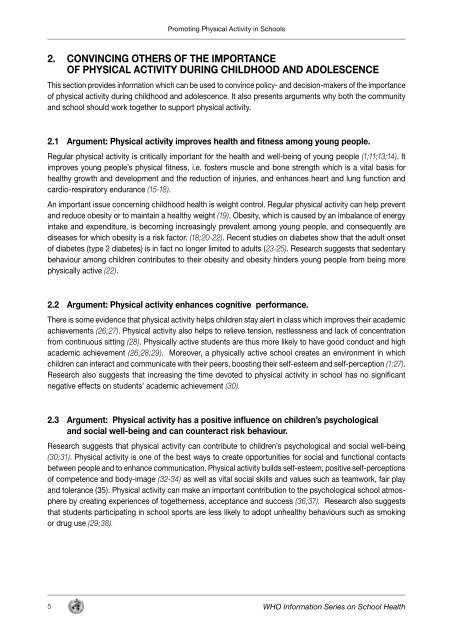WHO INFORMATION SERIES ON SCHOOL HEALTH ... - PAHO/WHO
WHO INFORMATION SERIES ON SCHOOL HEALTH ... - PAHO/WHO
WHO INFORMATION SERIES ON SCHOOL HEALTH ... - PAHO/WHO
You also want an ePaper? Increase the reach of your titles
YUMPU automatically turns print PDFs into web optimized ePapers that Google loves.
Promoting Physical Activity in Schools<br />
2. C<strong>ON</strong>VINCING OTHERS OF THE IMPORTANCE<br />
OF PHYSICAL ACTIVITY DURING CHILDHOOD AND ADOLESCENCE<br />
This section provides information which can be used to convince policy- and decision-makers of the importance<br />
of physical activity during childhood and adolescence. It also presents arguments why both the community<br />
and school should work together to support physical activity.<br />
2.1 Argument: Physical activity improves health and fitness among young people.<br />
Regular physical activity is critically important for the health and well-being of young people (1;11;13;14). It<br />
improves young people’s physical fitness, i.e. fosters muscle and bone strength which is a vital basis for<br />
healthy growth and development and the reduction of injuries, and enhances heart and lung function and<br />
cardio-respiratory endurance (15-18).<br />
An important issue concerning childhood health is weight control. Regular physical activity can help prevent<br />
and reduce obesity or to maintain a healthy weight (19). Obesity, which is caused by an imbalance of energy<br />
intake and expenditure, is becoming increasingly prevalent among young people, and consequently are<br />
diseases for which obesity is a risk factor. (18;20-22). Recent studies on diabetes show that the adult onset<br />
of diabetes (type 2 diabetes) is in fact no longer limited to adults (23-25). Research suggests that sedentary<br />
behaviour among children contributes to their obesity and obesity hinders young people from being more<br />
physically active (22).<br />
2.2 Argument: Physical activity enhances cognitive performance.<br />
There is some evidence that physical activity helps children stay alert in class which improves their academic<br />
achievements (26;27). Physical activity also helps to relieve tension, restlessness and lack of concentration<br />
from continuous sitting (28). Physically active students are thus more likely to have good conduct and high<br />
academic achievement (26;28;29). Moreover, a physically active school creates an environment in which<br />
children can interact and communicate with their peers, boosting their self-esteem and self-perception (1;27).<br />
Research also suggests that increasing the time devoted to physical activity in school has no significant<br />
negative effects on students’ academic achievement (30).<br />
2.3 Argument: Physical activity has a positive influence on children’s psychological<br />
and social well-being and can counteract risk behaviour.<br />
Research suggests that physical activity can contribute to children’s psychological and social well-being<br />
(30;31). Physical activity is one of the best ways to create opportunities for social and functional contacts<br />
between people and to enhance communication. Physical activity builds self-esteem, positive self-perceptions<br />
of competence and body-image (32-34) as well as vital social skills and values such as teamwork, fair play<br />
and tolerance (35). Physical activity can make an important contribution to the psychological school atmosphere<br />
by creating experiences of togetherness, acceptance and success (36;37). Research also suggests<br />
that students participating in school sports are less likely to adopt unhealthy behaviours such as smoking<br />
or drug use (29;38).<br />
5<br />
<strong>WHO</strong> Information Series on School Health

















